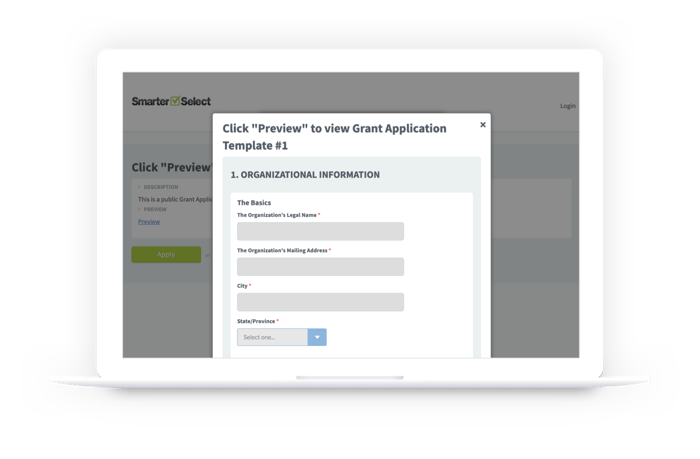Grant management is the process of successfully finding a recipient or a group of recipients for a grant that your institution is giving away. It typically begins with establishing a set of ideals that you hope your recipient(s) will embody, then creating an application, announcing the grant, collecting applications, evaluating them, and finally selecting a winner or winners. In this guide, we’ll be sharing our best secrets for running an efficient and effective grants program.

Table of Contents
|
CHAPTER 1 |
|
CHAPTER 2 |
|
CHAPTER 4 |
|
CHAPTER 5 |
CHAPTER 1
Introduction to Grantmaking
Let’s start with the basics by defining a grant. A grant refers to financial or equipment assistance issued to an individual, non-profit organization, or academic institution to help achieve a given objective. In other words, a grant is an assistance set aside to impact the community positively.
Grants are issued for a wide range of reasons including to tackle the environmental, social, or economic needs of a person, business, or community to improve the quality and quantity of life. Grants are given out by government departments, political parties, influential individuals, corporations, non-profit organizations, and multinational companies. However, some small grants are also given by society members and churches to do things like better their neighborhoods, fight crime, increase literacy levels, etc…
So then, what is grantmaking? Simply put, grantmaking is the process of creating, managing, reviewing, and awarding grants.
Organizations involved in grantmaking are called grantmakers and their grant management process can be a full-time gig. This is especially true when there are significant amounts of money available for awards.
The lifecycle of a typical grant program occurs in three stages:
Pre-Award
The grantmaker establishes the funding opportunities and creates an application. Then, they collect applications and evaluate them.
Award
The grant administration team chooses a recipient, or recipients and announces it to the public.
Post-Award
In this stage of the grant process, the grant management team surveys team members and applicants to see how the program went and prepares for the next round of grantmaking.
What are the best practices of Grantmaking?
As with all things, there’s a right way and a wrong way to go about grantmaking. Get it right, and you can have a smooth grant application process, and award your recipients with ease. Get it wrong, and you’ll have quite the mess on your hands. That’s why below we’re sharing 8 grantmaking best practices that can help you better manage your grant programs.
Pre-Qualify your Applicants
Pre-qualifying applicants with questions that quickly filter out unqualified applicants will ensure that only eligible applicants take the time to go through the process of applying.
This way applicants that are ineligible won’t waste their time or yours, and it will signal the people who are eligible that they are in the right place. This will ultimately help reduce the amount of time and energy you will have to spend vetting the applications you do receive.
Let Applicants Preview the Application Before Filling it Out
Those that decide to proceed to apply will have a clear understanding of how long it will take to finish the application, which will make them more likely to finish applying.
Also, the applicants that aren’t serious about trying to receive a grant will likely opt-out if they preview your application and feel the application is too long or too difficult. This will help your institution save time and resources by being certain that only people that are committed to the process are filling out an application.
Provide a Checklist of Key Items At the Beginning
Let your applicants know upfront if there are any documents they’ll need to have ready for their application. For example, if you need references that express why they should receive the grant, putting that in a checklist allows the applicant to have all materials ready in advance before actually applying.
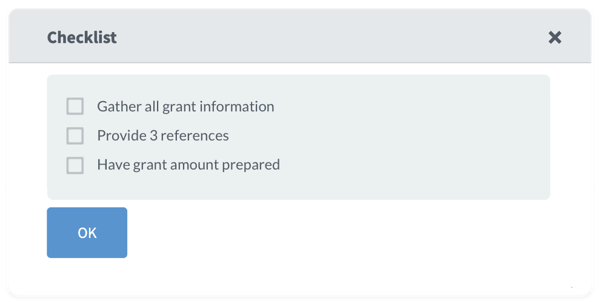
Provide Question-Level Help
Providing tooltips that give more context to your questions will help you avoid issues with your application. Question-level help also helps applicants to understand exactly what you’re looking for in a question, minimizing confusion and improving user experience.
Create an FAQ section
This tip, like the one above, will help you with handling questions from candidates regarding your application. Rather than addressing hundreds of emails from confused applicants asking the same questions over and over again, reduce the number of queries from applicants by having a FAQ section that takes care of the most common questions for you.

Communicate with Applicants
Send email and text reminders to your entire pool of applicants. Let your hopeful candidates know when deadlines are approaching and regularly inform them of what’s going on.
Setting up a Grant Timeline
Benjamin Franklin used to say “If you fail to plan, you are planning to fail!” and we couldn’t agree more. Plan out every element of your grant, and put it on a reasonable timeline so that you can create deadlines, and then inform your applicants about them. Think about things like:
- How long you need to secure the funds for the grant
- How much time you want to give candidates to submit their applications
- If there are specific dates you want to have your award announcement line up with, such as your company’s anniversary or the national date of a cause (i.e. World Obesity Day for a sustainable food systems grant)
- The amount of time that will be needed for evaluating applications (this will help you determine how much support personnel you will need as well)
Once you have a timeline of events, you can start planning out when to announce the grant, when to start recruiting candidates to apply, and so on.

“If you fail to plan, you are planning to fail!”
- Benjamin Franklin
Use Grant Management Software
Leveraging grant management software is the key to a smooth grantmaking process. With software, you will be able to get more done by working less. You can manage several thousand applicants, create automation for time-consuming tasks, easily build grant applications, and your overall user experience will be much better for both your team and applicants.
CHAPTER 2
Creating Grant Application Forms
After looking at countless grant application examples, some key elements stood out to us that we think every grant administration team should consider adding to their forms. These elements include, but aren’t limited to:
Asking for the organization’s pertinent details such as a contact person, address, city, state, phone number, etc…

Asking for the organization’s annual operating budget or the budget for the project they are requesting funding for.

Asking what they plan to do with the money if they are selected as a recipient .
When you are developing a grants program, there are so many elements to consider. You already have a lot to think about, it can get a little overwhelming. Wouldn’t it be nice to have a grant application template to help you design your own application form? Of course, it would!
That’s why we went ahead and created not just one grant application template for you, but four, so you can optimize your grants program to its maximum potential.
CHAPTER 3
Running an Efficient Application Review Process
Whether you’re paying employees or hiring volunteers, the people you bring on board to help you with your grant review process will be a critical component to your success. With the right personnel, you can run a better grantmaking program. However, we’d be remiss if we didn’t admit that there’s more to your program’s proficiency than your team. As such, below are some tips you can use to run a more efficient grant application review process.
Have a Plan Specifically for your Review Process
A construction crew doesn’t build a house without blueprints, and you shouldn’t try to figure out how to manage grants, let alone who should be on your grant application review team until you formulate a blueprint of your own.

In your planning, think about things like how many reviewers you anticipate you will need, and how much time will be necessary to review applications. It may be helpful to talk to other people in grantmaking to get their thoughts on how much support you should bring in.
Don’t Just Attract Anybody, Consider Your Ideal Reviewer
Setting up the ideal grant review team is of great importance. You want to have people on your team that match the vision and ideals of the grant.
These team members are your public representatives, so only fill the positions with individuals that embody your desired morals and values.

Use Software to Aid In Grant Project Management
Software is the most essential element in running an efficient grant review process. The reason? The software can work faster than anyone on your team can, and it will work 24/7 with a lower chance of errors.
For starters, using grant management software will help you instantly pre-qualify and filter out ineligible candidates so that only the people that are eligible submit an application. That step alone can save you the time of going through those unqualified applications.
Grant management software also allows you to add grant application rules that dynamically change the questions in your form based on the user’s answers. This whittles down the potential pool of eligible people without you doing any extra work and personalizes applications for a better user experience.
If that wasn’t enough, you can also create a scoring rubric and have answers automatically scored. Should you choose to, you could eliminate any application from your evaluation pool that didn’t reach a certain threshold, thereby cutting down on your grant review process time even further.
Another thing you can do is remove applications that haven’t submitted all requested documentation, essays, or relevant information before evaluations even begin.
While we’re saving time, we should share that using the right software eliminates the need to file paperwork and send/email sensitive or confidential data as well. Everything will be instantly available to your team members without the hassle or additional time of uploading and downloading files.
Finally, evaluators can share notes and scores, which allows your team to address concerns about applications that much faster. This can be extremely helpful towards the end of the application cycle to select the recipients when the pool of applicants is down to the best candidates.

CHAPTER 4
Post Award Grant Management
Once you’ve put in all the hard work of creating the application, announcing the grant, receiving the applications, evaluating them, and ultimately choosing your recipient(s). You’re finally done, right? Wrong! Now it’s the time to work on your post award grant management to-do list. Below is everything you should be doing right after your recipients are announced.
1
Feedback, feedback, feedback
Getting feedback from applicants, evaluators, donors, and pretty much everyone who had anything to do with your grant management process is the key to improvement. This is critical because it lets a grantmaker learn what went right and what went wrong. Information gathered in this process might help you have a smoother program the next time around.
Asking for feedback also lets everyone involved know that you truly care about how your institution is perceived and that you want everyone to have an enjoyable experience.

2
Dot Your i’s and Cross Your t’s With Grant Reports
Make sure all of your paperwork is filled out and filed properly. Any tax incentives/deductions you might qualify for will require that your grant reporting was well-documented and accurate. When tax season comes around you will have all the required documentation organized and ready to go.
3
Create the Grant Calendar for the Next Cycle
The sooner you start planning for the next grant management cycle, the easier it will be once you’re ready to launch your next program. Now is a great time to think about things like who will be on your grant committee - can you rely on the same people to join you for another round or will you need to secure new staff and volunteers?
You will also be able to apply some of the feedback received, do you need to extend how much time candidates have to fill out applications? Or perhaps you need more time for evaluations? Consider each step of the grant cycle and how it went last time as you make your plans for the next one.
CHAPTER 5
Avoiding Common Grantmaking Mistakes That Could Cause a Trainwreck
For some grantmakers, their mantra is “more awards, more problems.” but grantmaking should be an enjoyable process. After all, in the end, someone walks away with a nice check that can help them do something that they couldn’t do before.
For some grant management teams though, operating a grant program becomes a pile of problems that they never seem to have time to solve. Eventually, their grant program becomes a trainwreck that hits them when they least expect it. We don’t want to see that happen to you. That’s why below we’re sharing 8 grantmaking mistakes that could cause a trainwreck, and how to avoid them.
1
Too Many Unqualified Applicants
In an ideal world, only qualified applicants should be able to see your grant. While this might not be realistic, it’s something you should strive for. One great way of filtering out unqualified applicants is by making sure that your website and applications speak to your ideal recipients. Those that fit the criteria will feel identified and motivated to apply, while the ones that don’t resonate with the message will know they aren’t in the right place.
You can also filter out ineligible candidates even further with pre-qualification questions. These are incredibly effective at saving you the time of reviewing applications that weren’t even close to fitting the criteria of your ideal candidate.

2
Not Having Enough Time to Do it All
Most grantmakers have a common problem, not having enough time for all the things that have to get done to run a grants program. But fear not, this problem can usually be all but eliminated with better planning and with the help of technology.
The first thing grantmakers should do is develop an overview of how the entire process will go for their grants program. Thinking ahead of time about what-ifs prepares you for contingencies such as having extra help on standby when it comes time for evaluations.
The second part of avoiding this mistake is to utilize grant management software. By using software to manage your grants program, you will be able to regain control of your time while getting even better results than before by leveraging automation and easy management tools.
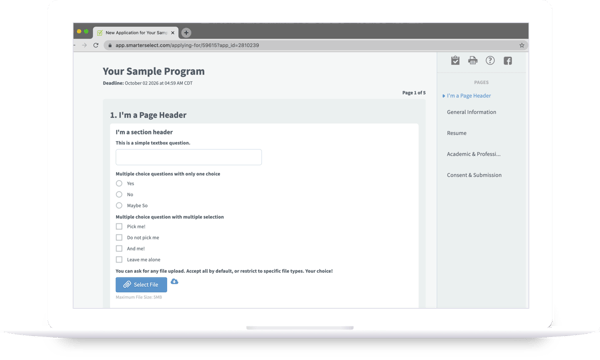
3
Complicated and Confusing Application Forms
Grant applications should flow smoothly to receive better responses. One way to do this is to group questions of the same category. For example, all questions about finances should be in one place, and all questions about goals for what to do with the money should also be in one place.
Don’t forget to add an FAQ section, question-level hints, and answer validation where applicable. Also, break down sections into bite-sized chunks, and to use plenty of multiple-choice questions where possible so the form feels less overwhelming.

4
Not Adding Buffers to Their plans
This goes back to planning. Add a buffer to sections of your plan, for example, consider how long you think it will take to evaluate your applications, and then add even more time as a buffer. You’ll want to also add a buffer to the number of reviewers you recruit, just in case someone drops out, and also add a buffer to the timeframe allotted for evaluations.
5
Not Acquiring The Right People
Your evaluation team must embody the same morals, goals, and values that your institution does. You need dependable personnel whether they are paid or volunteers, so make sure that during your recruitment process you are careful about who you add to your program.
6
Not Accounting for Human Errors in Data Entry
Your applicants and evaluators are human, they will make mistakes. That’s why you need to try to reduce the chances of those mistakes happening in the first place, or you risk confusing your evaluators and sometimes even rejecting great candidates by mistake. The best way to mitigate this risk is by using applicant management software that checks answers and makes automatic calculations for both applicants and evaluators.
7
Neglecting to Communicate With Your Donors, Team Members, and Applicants
Whether it’s your donors, team members, or hopeful applicants, people want to know what’s going on in the grant program they are invested in. From deadlines to how much money is being given away. Constantly email or text your entire audience with relevant information so that they are kept up to date on all the news they need or want to know.
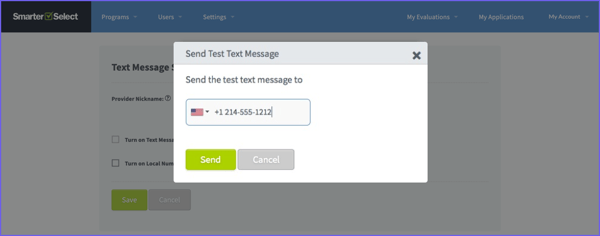
8
Failing to Measure and Track Everything
What gets measured, gets improved. If you don’t measure anything, how do you know what needs to be changed for the next round of grantmaking?
Make sure that you’re tracking all the data involved in your grant program, from the number of applications submitted to the number of emails sent. A great example of avoiding this mistake is by using grant management software. You can automate this part of the process with just a few clicks.
Grant management software allows you to easily create custom reports to analyze your applicant and evaluation data. This way you will be able to know how your program needs to be improved and you will have a better understanding of how you’re performing in each of your cycles.
CHAPTER 6
The Secret for Effective & Efficient Grantmaking
We’d be lying if we said you had to use grant management software to run a grant program. The truth is grantmaking can still be done with the old school methods of submitting physical copies of applications to an office where evaluators painstakingly assess them by hand. But, the old school method will take much more time and energy, and if you’re paying staff members, then it will certainly cost a lot more in the long run. That’s why we wouldn’t recommend these outdated practices.
Instant communication, no programming necessary, automated recommendations, and so much more make using grant management software a no-brainer. We know this because we have helped hundreds of organizations streamline their grant management process by utilizing our software, SmarterSelect. We can help you expand your impact too, while also making your process a lot less complicated.
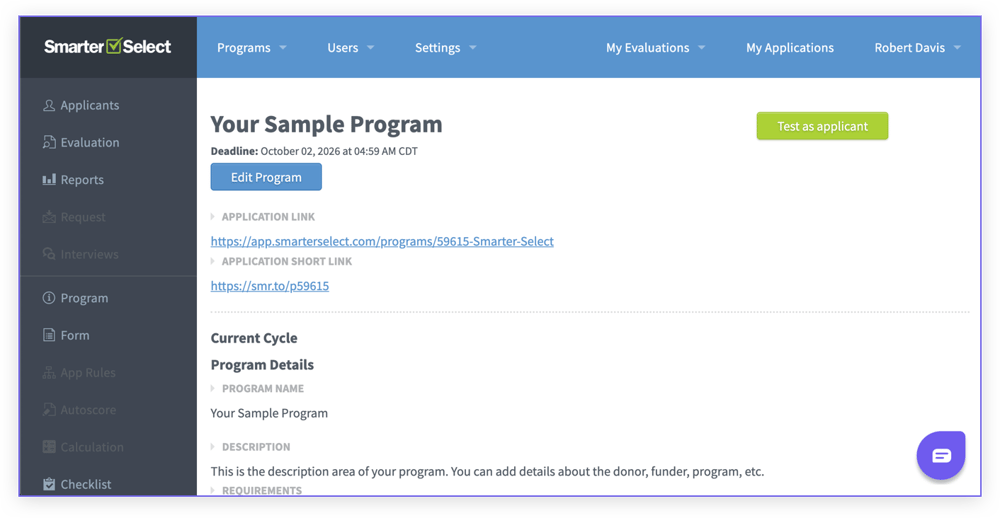
Discover just how much smoother your grant management process can be. Schedule a demo with us, and we’ll show you how we can give you back control of your time, energy, and results.
Streamline Your Grants Program
Priced for non-profits. No set-up fees.
No long-term contracts. Powerful features.
Go live in less than 24 hours.


